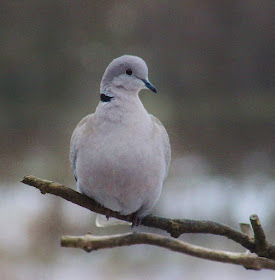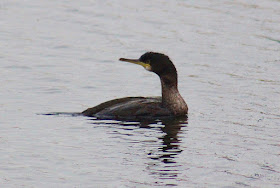There are no other ducks that display as much sexual dimorphism in bill structure as the scoters- Common Scoter's especially so. Isn't that weird. It's impossible to sex almost all other wildfowl on bill shape. Only some eiders share this feature, and even they rely mainly on fleshy protuberences rather than keratin.
A celebration of birding and natural history, generally within a 10 mile radius of Ely Cathedral, Cambridgeshire, UK. It would be great if you wanted to share your Ely 10 birding news, experiences, photos, art and video through this blog. Please contact hairyfolkster@gmail.com with your post or to join the authorship, I'll get you on the list quicker than a fly over Alpine Swift.
Pages
▼
Wednesday, 28 March 2018
Monday, 26 March 2018
I can't think of a pun- title for this.
No- I can't think. I'm sure there's a dodgy pun in there somewhere but I just can't find it without trying to shoehorn some reference to scrotums.
Needless to say I was delighted to come across the three Common Scoter at the settling beds yesterday afternoon. It was one of those quirks of fate that happen sometime. Dunc had already dropped in at the BF twice, so if I had gone down there any earlier things may have been different. As it was, due to another car parked in the best spot, I initially drove on by to check the fields further on to see if there were any watery puddles I could use for reference for a painting of grazing Wigeon I started the other day. On my way back, I pulled in to have a quick look at the gathering of Shoveler- and only got out the car after I heard a Wigeon whistle. Wigeon are not unusual visitors to the beds, but they don't turn up all that frequently, so they're always worth a quick look.
Scanning past the harlequin parade of twirling Shovelers, three sleeping duck caught my eye. Longish, stiff tails poking at acute angles, and the pale cheeks and dark crown of one of them immediately brought to mind ruddy duck, a species that used to be unnervingly common on this water- but two of the birds were black. I know there are dark stifftails in the Americas- but these must be scoters, surely.
The problem now was that I'd only come out for a quick gasp of fresh air really, and was therefore unprepared. I rushed home to get my camera, and text Dunc the news- figuring he might need Common Scoter for his Ely10 list that he doesn't keep at all except he knows exactly what he's got on it. Of course I forgot my specs, and so after half an hour of not really knowing if I was getting anything in focus, I made another trip back after Dunc arrived.
The air was virtually still, and the sun shone mostly- giving the two males a glossy sheen that turned brown as they changed angle, and made their eyes glow amber.
Across the back the Buzzards and Marsh Harriers briefly spiraled up together, and on the water the Shovelers mirrored them with their own spiraling fractal patterns. I did briefly notice three Wigeon, but priorities change. All-in-all it was a relaxing bubblebath of an afternoon, with pastel waters and sonorous birding. Mellow-nitta. There, I knew there had to be one somewhere.I hate myself.
Wednesday, 21 March 2018
being right is sometimes wrong
While the owl itself dries I thought the background should get some attention. I was quite pleased with the effect I was getting, but when I stood back, it suddenly struck me that my approach to the composition is a bit problematic. People who saw the owl at Snettisham might not even notice the problem- but if you weren't there watching this bird- with the big seawall looming up beyond it- you might look at this painting and wonder if perspective was just some minor detail I'd ignored completely. My vaguely abstracted motif only works as long as you know the reality it's based on.
I decided to leave it for a while and see if the background problem receded in my mind, so I picked up a smaller canvas and started another picture in which the background wouldn't be such an issue.
This time, I chose to paint the owl looking a bit more straight on- and immediately ran into another problem.
Owl eyes are captivating- and complex. The way they are set amid the voluminous facial disc presents a really annoying optical illusion. Look at any photo of an owl, and if the head is not directly facing you, the far eye will look wrong. Because the pupil is behind a thick lens, and the feathers around the bill obscure the inner part of the eye, you get an unfortunate cross-eyed look.
I tried not to let this effect bother me- it's anatomically right, so I have to paint it like that. I showed it to Dunc to see if he noticed the effect too. Unfortunately, he did.
Sometimes you have to cheat reality. There was only one thing for it. I had to repaint the eyes wrongly, to make them look right.
Sunday, 18 March 2018
Celsius
The media dubbed a recent old fashioned snow flurry as "The beast from the east", the snow's terrible for many birds if it hangs around long but does provide some close views of birds taking a few more risks to intake the needed calories. The garden was visited by a wider variety of species and the reflected light illuminating the underside of birds makes plumage sing.
Possibly displaced by the cold weather an immature Shag appeared at the Cambridge Research Park over a week ago but I kept missing it. Today I did see it but it was hidden away under a jetty and I may well have missed it at this spot on my previous visits.
When the bird took to the water it showed well and was a very welcome addition to my Ely10 sightings.
The wind was biting hard, fingers burnt with the cold after a few minutes out of gloves. I headed to Chain Corner to have a second look at the Ring-necked Duck which was bobbling around in the choppy waters amongst the Pochard.
At Ely Beet Pits a 25 strong flock of Shoveler were spiralling in a tight circle, heads under but pushed towards the centre and the flock was moving in a spiral. I'm expect that this is an effective way to create a current and draw food closer to the surface but it's the first time I have seen this behaviour, which I'm going to call kettleing, particularly interesting given the reasonable size of the flock.
I was back home by 9 as we were due to visit Walthamstow. I managed to squeeze in 30 minutes at the Wetlands reserve and took seconds on the Little Bunting which was drawn to a seeded area. Secretive and keeping within cover the lovely bunting did show closely although the cold again was drilling through to the bones. Spring I am sure will spring before long.
Wednesday, 14 March 2018
I didn't have a pushchair to take the weight.
There are some birds that demand attention. The Snowy Owl is one of those birds- a myth blown in by the north wind. As it perched up on a fencepost it constantly shifted it's gaze from side to side, a look of disdain in it's catlike eyes. There was a weight to this bird, despite the lightness inherent in it's thermal plumage.
The constant turning of its head made it difficult to sketch in detail- the subtle changes in shape of eye and pout and facial disc were hard to describe in pencil alone, and I left the bird with a sense of frustration. I hadn't captured it- or at least I had grabbed and been left with only a handful of downy feathers.
I have painted a few owls before, and I wanted to make a start on this one before the memory of it faded too much. There is nothing like an owls head to test one's ability to carve out a complex shape in paint. There are intuitions to overcome. If an owl faces you head on, you expect to see both eyes clearly- but it doesn't take much of a change in angle to obscure the further eye, as the feathers surrounding the bill jut forward. An owl's face is not a flat plane, and in dull light it can be hard to make out any structure. There were subtle warm ochreous shadows around the eyes, and this was something I focused on to find the character of the bird.
Once happy enough that I'd got the basic shape of the head, I worked on the rest of the body, using photos as a guide to get the pattern of bars and wedges and drops as close as possible to the real thing.
The dilemma now was how to proceed. I needed to paint the white of the feathers, without losing the pattern I'd just marked out. Leaving the paint to dry for a while, I guessed that a thin layer over the top would cover, but not entirely obscure the dark pattern, and I was right, but perhaps a little hasty. The dark bars had not dried completely, and as I dragged the brush over the canvas, some of the dark paint was dragged out with the white. I decided to continue- feeling that the streaking effect would help add to the texture of the feathers.
I really will have to wait now for the paint to dry before I continue, in order to refine the pure white feather base colour.
Monday, 12 March 2018
Snowdive
I had a WOW day. On the 10th March 1991 I saw the Wainfleet Snowy Owl for the 4th and last time. I haven't seen one since despite several weeks spent in the high arctic and several failed attempts to see one whilst working on the Hebrides. 27 years on, almost to the day and I got to enjoy this spectacular species in the wild again. I knew it was a long walk down the beach at Snettisham and bundled the 3 year old in the pram, mid way Ben started having some issues with the vigour of the aerobic exercise, mentioned something about burn and lactic acid. The Owl had been relocated for a third day and has moved quite a way from Burnham Overy around to the Wash. When we did get to the end of the pits and on to the boardwalk I was elated to see the Owl was really close and hunkered down on the top of a grassy hummock.
After 5 minutes or so the bird became very alert opened it's wings and flew, WOW. I was convinced it would glide over the sea defence and out of sight but it did the opposite and took up sentinel on a fence post. The following hour was spent watching this epic bird doing it's thing. Activity peaked at spells of preening but every time I looked in the scope the serotonin rushed around my brain. I just couldn't get my head around seeing the bird this well. I was like the Cheshire Cat, Mark reckons he's never seen me so happy to see a bird and it certainly felt that way.
The walk back was meandering and we shared the post Owl buzz with Ely's finest, as a Wildspace posse had formed and raided the coast. The sky bruised and we returned to the Fen for tea and medals.




























